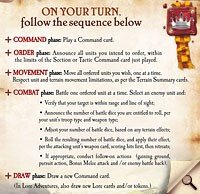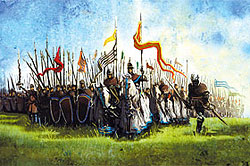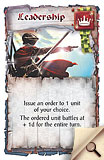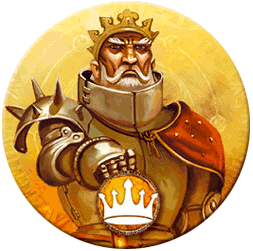Wednesday, September 27, 2006
Official Word: The Play of Command
 The latest post on the official DoW blog is a general one about gameplay, going over concepts familiar to Memoir ‘44 and C&C: Ancients. However, some of the ‘criticisms’ that are often levelled at the Commands and Colors system games are specifically addressed and discussed.
The latest post on the official DoW blog is a general one about gameplay, going over concepts familiar to Memoir ‘44 and C&C: Ancients. However, some of the ‘criticisms’ that are often levelled at the Commands and Colors system games are specifically addressed and discussed.
First we get a look at the sequence of play, which follows the usual order, however several follow-on actions are listed: gaining ground, pursuit, bonus melee attack and enemy battle back.
Gaining Ground and Pursuit probably have their equivalents in Memoir ‘44 as Advance and Armor Overrun; in C&C: A as Advance and Momentum.
In the latter game there is also a Battle Back option, like we see here, which reflects the more hand-to-hand nature of historical combat. This should certainly lead to more intense and protracted melee situations.
 The bulk of the post talks about the Commands & Colors system. Despite the fact that the game system works beautifully, some critics believe that the card-driven nature of the play detracts from the historical reality—why, for example, would you not be able to activate a unit on the right flank just because you don’t happen to have a card at that time that allows you to do so?
The bulk of the post talks about the Commands & Colors system. Despite the fact that the game system works beautifully, some critics believe that the card-driven nature of the play detracts from the historical reality—why, for example, would you not be able to activate a unit on the right flank just because you don’t happen to have a card at that time that allows you to do so?
 The answer is part gameplay, part history. The card system rewards the strategic use of cards, forcing players to marshall their hand of cards in such a way as to be able to put their plans into action.
The answer is part gameplay, part history. The card system rewards the strategic use of cards, forcing players to marshall their hand of cards in such a way as to be able to put their plans into action.
It’s pointed out that the cards could be thought of as a limited set of battle instructions you have for the battle; also that since the deck is used by both players, if your opponent has a number of left flank cards, you will have more opportunity to draw right flank (ie. opposite flank) cards; and that Tactic cards also give you an added level of flexibility. Historically, it’s obvious that battlefield communications were unreliable and that the chaos of battle is a factor. Whichever way you justify the system, there’s no denying it makes for a challenging, interesting game.
There’s also a mention of the battlefield hexes that are bisected by flank lines, and their tactical advantage since they lie in two sections and can thus be ‘activated’ more often. It’s pointed out that they can be hotly contested due to this advantage. I’m not sure of the historical justification for this, if any, but it’s another factor that has to be taken into account when formulating your play strategies.
 Finally, another War Council member is revealed: the Commander. We are told he dictates the size of your Command card hand, and indeed the same Command ‘crown’ symbol is on his token. Looking at the Rogue War Council member here, we see she has a ‘Mask’ symbol—what could this signify?
Finally, another War Council member is revealed: the Commander. We are told he dictates the size of your Command card hand, and indeed the same Command ‘crown’ symbol is on his token. Looking at the Rogue War Council member here, we see she has a ‘Mask’ symbol—what could this signify?
Some Section cards activate units ‘Equal to Command’, which is the number of levels allocated to the Commander. It’s beginning to look as though you can allocate levels among your War Council members to suit your playing style: to speculate, perhaps more to your Commander, allowing you to play more Command cards, but a corresponding lesser amount to a Wizard, giving you less strength in Lore—or vice versa. All should be revealed soon when the War Council is discussed.